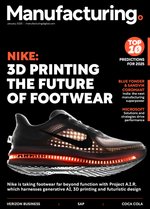New Year, New Manufacturing: Time to Build Your AI strategy

"AI is not just a tool for optimising processes, it is a transformative force that redefines the way we view efficiency, innovation and competitiveness in the industrial landscape. ” said Taline Forsberg, Vice President of Digital Products and Services, Sandvik Coromant last year.
This sentiment continues to ring true as industry adoption intensifies, with many manufacturers this year set to begin or advance their 'AI journey'.
Within this journey AI is more than just a tool to optimise existing processes, but a transformative force capable of reshaping the landscape of work itself.
To fully harness this transformative force in 2025, manufacturers can benefit from looking back at the insights of Sandvik Coromant's whitepaper.
Embracing AI’s potential
To ensure they are ready for AI’s transformative power, manufacturers must approach the technology with a proactive mindset, as outlined in the whitepaper.
Here are five essential lessons manufacturers can learn from Sandvik Coromant:
1. Get exploring
Manufacturers must remain curious and open-minded, adopting a mindset of constant exploration.
Staying engaged with new AI technologies, attending workshops, and keeping abreast of the latest trends are key to ensuring companies stay ahead of the curve.
2. Learn AI to master AI
AI is not a monolithic technology.
With many subtypes and applications, it is critical for manufacturers to gain a deep understanding of how AI works.
Continuous learning will be essential for leveraging AI to its fullest potential, as this field evolves rapidly.
3. Harness human creativity
While AI excels at routine tasks, it cannot replace human creativity, critical thinking, or interpersonal skills.
As AI handles more operational tasks, workers should focus on honing the "people skills" that will remain essential for driving innovation and collaboration.
4. Protect the workplace
As AI and automation become more prevalent, workers must take on the role of ensuring workplace safety and maintaining these advanced systems.
This responsibility includes understanding AI's capabilities and limitations to ensure it serves both the people and the business effectively.
5. Adapt and stay agile
The future will require adaptability.
Manufacturers must be ready to pivot and evolve as AI continues to transform the industry.
The need for upskilling workers
One of the most crucial aspects of adapting to AI in manufacturing is upskilling the workforce.
The global manufacturing sector is already grappling with a shortage of skilled workers, and the rise of AI only underscores the need to equip workers with the right knowledge.
AI and automation can handle repetitive, mundane tasks, enabling workers to focus on more complex, high-level work that demands creativity and critical thinking.
However, workers must be prepared for this shift, and manufacturers have a responsibility to ensure their employees are not left behind.
- Digital Twins
- Predictive maintenance and monitoring
- Cobots
As Karin Kimbrough, Chief Economist at LinkedIn noted in the whitepaper, the real challenge lies in how people will adopt these tools and continue to hone the skills that complement them.
When it comes to AI's power to augment and improve the three key areas the whitepaper highlights, manufacturers must also ensure they are exploring who will manage these systems.
Employee training is vital to master digital twins and cobots, so the benefits of AI can be fully realised in these areas.
With this realisation comes increased freedom for employees, who can instead focus on higher level problem-solving and process management tasks as opposed to mundane tasks.
AI adoption needs to be handled strategically, ethically and intelligently- because its no longer a futuristic concept.
The technology is here, it isn't going away, and it can be beneficial to manufacturers and their staff if implemented correctly.
By heeding Sandvik Coromant's advice, manufacturers can build a framework to do exactly that this year.
Explore the latest edition of Manufacturing Digital and be part of the conversation at our global conference series, Manufacturing LIVE.
Discover all our upcoming events and secure your tickets today.
Manufacturing Digital is a BizClik brand.


